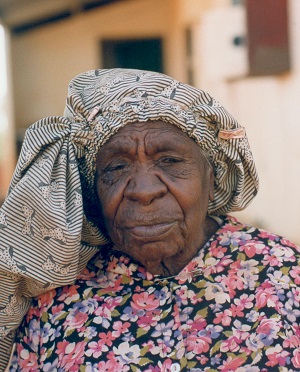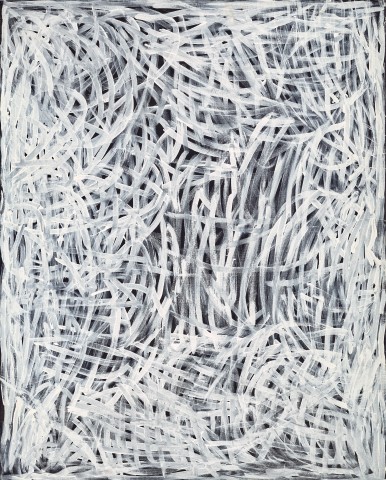UNTITLED (YAM), 1996
EMILY KAME KNGWARREYE
synthetic polymer paint on linen
151.0 x 122.5 cm
bears inscription verso: artist's name and Delmore Gallery cat. 96F052
Delmore Gallery, Alice Springs, Northern Territory
Private collection, Melbourne
Emily Kame Kngwarreye: My Mother Country, Kunsthaus Zug, Switzerland, October 2019 – February 2020
Emily Kame Kngwarreye NEW.jpg

Renowned for her colourful, vibrant paintings based on the ever-changing desert landscape in her father and grandfather’s Country of Alhalker, Emily Kngwarreye was deeply rooted in the Anmatyerr land of her ancestors to whom she paid respect through a lifetime of ceremonial song, dance and painting. Her art chronicled on canvas this triangular shaped country, where Emily was born, the youngest of three children, and where she lived in the ways of the eastern Anmatyerr. In 1926, the traditional life of the Anmatyerr and Alyawarr people was disrupted, when the borders of the Utopia pastoral lease were drawn across their lands and from there, local people including Kngwarreye found work on the emergent pastoral stations. Many years after, in 1977, she was introduced to batik as part of adult education classes on Utopia Station and ten years later, in 1988‒89, painted her first work on canvas, sparking a meteoric rise to fame.
In the months before she died, Emily Kame Kngwarreye was living at Delmore Downs Station with Lily Kngwarreye and her family. Although her output had reduced markedly, the final works painted for Delmore Gallery were a small group of powerful and dynamic monochromatic canvases executed on a black ground. Before beginning each new canvas, Emily would survey the various pots of coloured paints that were stored under the wide veranda of the Delmore homestead. Selecting her chosen colour of red, blue or white acrylic paint and carrying the tin to the primed canvas, she would then sit and begin the next work.
Untitled (Yam), 1996 is one of those remarkable late paintings – a masterpiece of strength and simplicity. The single colour, in this case a bright white, is applied lightly with a translucent quality in web-like traceries spread energetically across the canvas limited only by the reach of the artist’s arm. The sweeping arcs of white paint intersecting, overlaying and crossing in a series of gestural strokes mirror the subject of her painting – the meandering rhizomatic roots of the Arlatyeye plant (the pencil yam - Vigna lanceolata) and the cracks that form in the ground when the pencil yam ripens – while at the same time highlighting the intimate process between artist and canvas.
As Janet Holt states in the accompanying certificate, ‘As a monotonal painting, our engagement with the line is captured well and we find the live energy here intoxicating. We track the path of each stroke as she confidently reaches out across her canvas surface to place her arced lines of ritual body painting practice.’1
More than two decades have passed since Emily Kngwarreye died in September 1996, yet her name remains synonymous with the best of Australian Indigenous art. An original, intuitive and often enigmatic artist, her painting career lasted less than a decade, but the critical acclaim for her prodigious output has not diminished and her reputation has been sustained both in Australia and internationally.
1. From the accompanying Delmore Gallery certificate of authenticity
CRISPIN GUTTERIDGE
